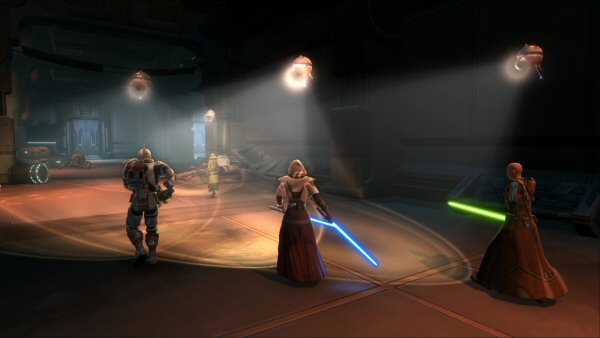The announcement didn’t exactly came as a surprise; with Electronic Arts frequently talking about how freemium is the future and stating that having a subscription model in a free-to-play world is challenging was enough to see that something was brewing. And that something is the inclusion of a free-to-play model in Star Wars: The Old Republic next fall.
While some sectors still go completely against free-to-play, ignoring the obvious rise and domination of this business model, the ‘fall’ of Star Wars: The Old Republic may be the final hint that subscription-based MMO games are becoming a thing of the past. The massive ambition from the EA and BioWare game – and the colossal budget to go along with it – wasn’t enough to make the untouchable World of Warcraft shiver, an MMORPG that is also seeing a slow but steady decline in subscriptions. Not even one entire year after launch, SWTOR gave up and is now getting ready to welcome a few millions of free-to-play adepts, some of them actively cheering and waiting all this time for the game to ‘collapse’ and be forced to change its business model.
So, between many players wanting a great Star Wars MMORPG developed by BioWare and the free-to-play announcement, what failed? Not as much as you might think. Star Wars: The Old Republic is not a disappointment per se, but more of a case of not living up to the impossibly huge expectations that Electronic Arts (and many players) had set. And while this move to free-to-play is becoming more and more common – The Lord of the Rings Online, DC Universe Online, APB: Reloaded, Aion and so many others – this isn’t necessarily a sign of a failed game. In fact, conspiracy theorists would even say that they planned to get some months of paid subscriptions for as long as they could before adding the F2P model. It’s a stretch, but who knows?
Maintaining subscriptions is an obvious and lucrative thing, but the major share of revenue will come from free-to-play. Although most players never really buy anything, a small group is willing to support the game – and their progress in the adventure – with their wallets. If history teaches us anything is that the game’s profit will skyrocket (think 100%, 200% or more) in the initial months. Now why wouldn’t anyone want to release their MMO as free-to-play from the beginning – which brings us to the question above?
One way to reinforce the idea that SWTOR is changing due to high expectations is by taking a look at some of the remaining MMOs in the market. Rift is a current case of success but it’s unlikely that it will keep its stride when a certain Guild Wars 2 (in which you only pay the price of the game) is released. EVE Online is a completely different case, one set within a free world and an astonishing amount of content (and extremely steep learning curve) that has no proper competition despite being a subscription-based MMO. And then there’s The Secret World, another Electronic Arts-published MMORPG from the same makers of Age of Conan: Unchained (another game that turned to free-to-play to fight declining subscriptions). Although seen as a quality game, The Secret World is very likely to become F2P in a year or so, with the regular free weekends offered hinting at the urgent need to attract more players.
SWTOR is often accused of having tried too hard to copy the World of Warcraft model; this may be part of the reason, but the real reason is that story-based MMOs don’t seem to cut it anymore (see EVE Online for the opposite). For an MMO to maintain its appeal it has to offer something beyond a story – a world to be a part of, where players get into a Second Life kind of activity and don’t cry for new content just a month after release. Scripted content isn’t enough, there has to be something more than that, including a massive focus on the social side of things. Keep players involved and they will stay for a while.
That being said, there is still hope for the subscription MMO. Blizzard will have everyone looking to their Project Titan and even EVE Online’s CCP has got some attention to World of Darkness. However, it’s just too little to prevent us from saying that the subscription model is nearly dead and that free-to-play is the way to go in the future. With studios such as Crytek (Warface), Epic Games (Mercenary Ops) and THQ claiming the exact same thing, it’s hard to foresee a different scenario. And when Electronic Arts makes this move for a game whose development costs are estimated to be between $150 million and $200 million, then all doubts are gone.
If you click on a link and sign up for a game we may receive a small commission. Read our affiliate policy.



















 Facebook
Facebook Twitter
Twitter RSS
RSS